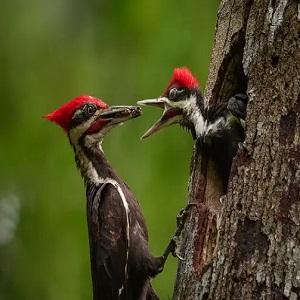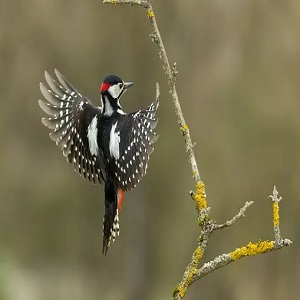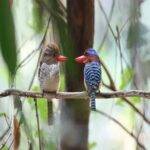Louisiana, with its rich and diverse ecosystem, is a haven for wildlife enthusiasts and nature lovers alike. Amidst the bayous, wetlands, and lush forests, one group of avian creatures stands out both for their captivating behavior and ecological significance – woodpeckers. These remarkable birds, with their distinctive drumming sounds and vibrant plumage, have found their home in the heart of the Bayou State.
In this comprehensive guide overall, “Fascinating Woodpeckers in Louisiana: A Guide to the Species and Their Habitat,” we embark on an exploration of these remarkable avian residents. From the dense forests of the northern regions to the vast wetlands of the southern coast, we will delve into the world of Louisiana’s woodpeckers, discovering their unique characteristics and the environments they call home.
Join us as we unravel the secrets of these captivating birds, their vital roles in the delicate balance of Louisiana’s ecosystems, and the conservation efforts undertaken to ensure their continued presence in the Pelican State. Whether you are an avid birder, a curious naturalist, or simply someone who appreciates the beauty of nature, this guide is your invitation to get to know Louisiana’s woodpeckers intimately and to explore the habitats they share with a wide array of wildlife. So grab your binoculars, put on your hiking boots, and let’s embark on a journey into the enchanting world of woodpeckers in Louisiana.
Understanding Woodpeckers: An Overview

Woodpeckers are remarkable birds known for their distinctive behavior. With specialized adaptations such as chisel-like beaks and shock-absorbing skulls, they drum on trees to find insects and create nesting cavities.
Species like the Pileated Woodpecker and Downy Woodpecker found in various North American habitats, including forests, woodlands, and urban areas. These charismatic birds contribute to forest ecosystems by controlling insect populations and serve as captivating subjects for bird enthusiasts and researchers alike.
What are Woodpeckers?
Woodpeckers are a diverse family of birds known for their unique adaptations and behaviors. Characterized by their strong bills, these birds are specialized for drumming on trees, which they do for various purposes.
Woodpeckers use their bills to excavate cavities for nesting, find insects hidden beneath bark, and communicate with one another through rhythmic drumming.
They have strong neck muscles to withstand the force of their pecking, protective features like shock-absorbing tissues in their skulls, and long, sticky tongues for extracting insects. Woodpeckers found in various habitats worldwide and are important for pest control and ecosystem balance.
What do Woodpeckers eat?
Woodpeckers have specialized diets primarily consisting of insects, but they also consume other food sources. Their diet includes insects like ants, beetles, caterpillars, and grubs, which they extract from tree bark and crevices using their strong bills and long, sticky tongues. They also feed on spiders, tree sap, and fruits when insects are scarce.
Basically, Woodpeckers are excellent foragers and have adapted to find hidden insect larvae beneath tree bark. They drum on tree trunks to create vibrations that disturb insects, making them easier to locate. Additionally, they consume berries and fruits during the non-breeding season, providing a more varied diet.
Certainly these various food sources allows woodpeckers to adapt to changing seasons and conditions. Their specialized feeding techniques and diets make them essential contributors to their ecosystems, as they help control insect populations and shape the health of the forests they inhabit.
The nest cavity of Woodpeckers
Woodpeckers are renowned for their impressive nesting abilities, creating intricate and secure nest cavities in various habitats. These cavities serve as not only shelter for their young but also have broader ecological implications.
Basically Woodpecker nest cavities are typically excavated by the adults using their strong bills. These cavities are meticulously crafted with small entrance holes to deter predators and often deep enough to accommodate their chicks. The insides of these nests are softened by wood chips, which provide a comfortable and insulating environment.
These nest cavities are critical for many other species. Once the woodpeckers abandon their nests, secondary cavity nesters, such as owls, squirrels, and small mammals, often take over these prime real estate spots. So this demonstrates the vital role woodpeckers play in ecosystem dynamics by creating housing opportunities for a diverse range of wildlife.
In “Louisiana“, woodpeckers like the Pileated Woodpecker can be observed making these intricate nesting cavities in mature forests, contributing to the region’s rich biodiversity.
Size and shape of a Woodpecker entrance hole
A woodpecker’s entrance hole is a vital component of its nesting and foraging behavior. These holes vary in size and shape based on the specific woodpecker species, the purpose of the hole, and the type of tree being used.
Surely, woodpecker entrance holes are small to medium-sized, with a circular or oval shape, the size can range from about 1 to 3 inches (2.5 to 7.6 centimeters) in diameter. However, the size can be larger for some species like the Pileated Woodpecker, which can create holes up to 4 inches (10 centimeters) wide.
The shape of the entrance hole is often rounded, allowing the woodpecker to access the interior of the tree easily. It is important to note that these holes are meticulously crafted by the woodpecker’s powerful bill. They serve as entryways to reach insect prey, excavate nesting cavities, and store food. The size and shape of the hole are adapted to the woodpecker’s needs, ensuring it can fulfill its various ecological roles in the ecosystem.
The Fascinating World of Louisiana Woodpeckers

Undoubtedly, the fascinating world of Louisiana woodpeckers offers a glimpse into the diverse avian life that thrives in this southern state. Among the most captivating species is the Pileated Woodpecker, known for its impressive size, striking black plumage, and iconic red crest. These birds found in mature forests, swamps, and bottomland hardwoods.
Another remarkable resident is the Red-bellied Woodpecker, featuring a distinct red cap atop its head and a vibrant belly. They are versatile, inhabiting woodlands, suburban areas, and parks throughout Louisiana.
Downy Woodpeckers, with their diminutive size and distinctive white undersides, are a common sight, often seen in various habitats, including gardens and woodlots.
Surprisingly Louisiana’s woodpecker species contribute to the state’s rich biodiversity, playing essential roles in maintaining ecosystem health and providing birdwatching enthusiasts with countless opportunities to observe their captivating behaviors and vibrant plumage.
Most Common and Rarest Woodpeckers in Louisiana
Specifically the most common woodpecker species in Louisiana include the Northern Flicker, Downy Woodpecker, and Red-bellied Woodpecker. The Northern Flicker is easily recognizable by its spotted underparts and distinctive “flickering” flight pattern. Downy Woodpeckers are smaller, with a white underside and black wings adorned with white spots. Red-bellied Woodpeckers have a red cap on their heads, which can be misleading as their bellies are more pale. These species found in various habitats, including forests, parks, and even suburban areas, where they feed on insects and tree sap.
Conversely, the Ivory-billed Woodpecker is the rarest and most elusive woodpecker in Louisiana. Historically, it inhabited bottomland hardwood forests in the southeastern United States, including Louisiana, but habitat loss and hunting have severely impacted its population. Extensive efforts are underway to confirm its existence and conserve its habitat.
What Do Woodpeckers Eat? 7 Most Important Things
The Largest and Smallest Louisiana Woodpeckers
In Louisiana, woodpeckers come in various sizes, with the Pileated Woodpecker being the largest and the Downy Woodpecker being one of the smallest. Here’s a closer look at these two Louisiana woodpecker species:
1. Pileated Woodpecker (Dryocopus pileatus):
- Size: The Pileated Woodpecker is the largest woodpecker species in Louisiana.
- Description: These woodpeckers are quite large, measuring around 16 to 19 inches (40 to 49 cm) in length, with a wingspan of 26 to 30 inches (66 to 76 cm). They have striking black plumage with bold white stripes on their faces and large red crests.
- Habitat: Pileated Woodpeckers prefer mature forests, swamps, and bottomland hardwoods. They found in large, wooded areas with plenty of dead trees for foraging and nesting.
2. Downy Woodpecker (Picoides pubescens):
- Size: The Downy Woodpecker is one of the smallest woodpecker species in Louisiana.
- Description: These woodpeckers are petite, measuring approximately 5.5 to 6.7 inches (14 to 17 cm) in length, with a wingspan of about 9.8 to 11.8 inches (25 to 30 cm). They have a black and white coloration, with a small bill and a distinctive white belly and back.
These two woodpecker species represent the extremes in size among Louisiana’s woodpecker population. While the Pileated Woodpecker knows for its large size and striking appearance, the Downy Woodpecker admires for its tiny yet charming presence in both natural and human-made landscapes.
A Detailed Look at Woodpecker Species in Louisiana

Louisiana boasts diverse woodpecker species, each uniquely adapted to its habitat. The Pileated Woodpecker, the largest in the state, with striking black plumage and a vibrant red crest, thrives in mature forests and bottomland hardwoods. The Red-bellied Woodpecker sports a reddish crown and belly, often found in woodlands and urban areas.
The Downy Woodpecker, petite and black-and-white, frequents parks and gardens, displaying impressive acrobatics. The Hairy Woodpecker, resembling the Downy, prefers mixed woodlands. The Northern Flicker, with distinctive markings, enjoys open spaces and lawns. Louisiana’s diverse woodpecker species enrich the state’s ecosystems and delight bird enthusiasts.
1. Yellow-bellied Sapsucker
The “Yellow-bellied Sapsucker” (Sphyrapicus varius) is a migratory woodpecker species found in Louisiana during the winter months. Recognized by its distinctive black and white plumage, it is named for the faint yellow hue on its belly.
These woodpeckers known for their unique feeding behavior, drilling rows of small holes in trees to feed on sap and insects attracted to it. Their presence benefits other wildlife, such as hummingbirds, who also enjoy the sap. Yellow-bellied Sapsuckers typically found in mixed woodlands and forests with ample deciduous trees, particularly during their winter stay in Louisiana.
2. Red-headed Woodpecker
The “Red-headed Woodpecker” (Melanerpes erythrocephalus) is a striking bird species native to Louisiana. Recognizable by its vibrant red head, white body, and bold black wings, it stands out in wooded habitats and open areas. This woodpecker knows for its remarkable agility in catching insects mid-air and caching food by wedging it into tree crevices.
Red-headed Woodpeckers thrive in a variety of habitats, including woodlands, orchards, and wetlands. Unfortunately, their populations have faced decline due to habitat loss, making conservation efforts crucial to preserving this iconic woodpecker in Louisiana.
3. Red-bellied Woodpecker
The “Red-bellied Woodpecker” (Melanerpes carolinus) is a common sight in Louisiana. Despite its name, its red belly is often difficult to see. These medium-sized woodpeckers are recognized by their zebra-like black-and-white markings on the back and a red cap on their heads.
They adapt well to suburban areas, frequently visiting bird feeders. Red-bellied Woodpeckers mainly feed on insects, seeds, and fruits. Their distinctive “quor” call and drumming sounds can be heard throughout Louisiana’s woodlands and urban landscapes.
4. Downy Woodpecker
The “Downy Woodpecker” (Picoides pubescens) is one of Louisiana’s smallest woodpecker species. Measuring around 5.5 to 6.7 inches in length, it has a black and white plumage pattern with a distinctive white belly and back. These adaptable birds often found in a variety of habitats, including woodlands, parks, gardens, and urban areas.
Downy Woodpeckers use their small bills to probe for insects on tree branches and trunks. They are frequent visitors to bird feeders, delighting birdwatchers with their petite yet charming presence.
5. Hairy Woodpecker
The “Hairy Woodpecker” (Picoides villosus) found in Louisiana. It shares a similar black and white plumage pattern but is slightly larger, measuring about 7 to 10 inches in length.
These woodpeckers inhabit wooded areas, forests, and parks, often foraging for insects and larvae on tree trunks and branches. Their distinctive calls and drumming sounds hear throughout the state, adding to the auditory tapestry of Louisiana’s woodlands.
6. Red-cockaded Woodpecker
These woodpeckers excavate cavities in mature pine trees, creating crucial nesting sites. Habitat loss and fragmentation have severely impacted their populations, leading to conservation efforts in Louisiana to protect their specialized habitat and promote their recovery through habitat restoration initiatives.
7. Pileated Woodpecker
The “Pileated Woodpecker” (Dryocopus pileatus) is the largest woodpecker species found in Louisiana. It boasts striking black plumage, a prominent red crest on its head, and white markings. With a length of 16 to 19 inches and a wingspan of 26 to 30 inches, these woodpeckers are often spotted in mature forests, swamps, and bottomland hardwoods.
Their distinctive call and large, rectangular-shaped excavations on trees make them easily recognizable. Pileated Woodpeckers play a vital role in forest ecosystems by foraging for insects and creating nesting cavities in decaying trees.
8. Northern Flicker
The “Northern Flicker” (Colaptes auratus) is a unique woodpecker species in Louisiana. It exhibits a distinctive appearance with a beige or tan body covered in black spots and a prominent white rump patch that’s visible during flight. Unlike other woodpeckers, flickers often forage on the ground for ants and beetles.
Their presence mark a loud “wick-a-wick-a-wick” call and a rhythmic drumming sound during courtship displays. Northern Flickers inhabit open woodlands, grasslands, and suburban areas, making them a common and adaptable sight in the state.
9. Ivory-billed Woodpecker
The “Ivory-billed Woodpecker” (Campephilus principalis) is a highly elusive and critically endangered woodpecker species in Louisiana, with unconfirmed sightings causing much excitement among bird enthusiasts. These woodpeckers know for their large size, striking black-and-white plumage, and ivory-colored bills.
Historically, they inhabited bottomland hardwood forests in the southeastern United States, including Louisiana. Habitat loss and logging have greatly reduced their population. Conservation efforts continue to focus on potential rediscovery and habitat preservation to protect this iconic, yet possibly extinct, woodpecker species in Louisiana.
How to Attract Woodpeckers to Your Backyard

To invite these fascinating birds, follow these tips:
- Provide Food: Woodpeckers primarily feed on insects, so install suet feeders with a variety of suet cakes. Include nut-based feeders or offer sunflower seeds, peanuts, and mealworms, which they also enjoy.
- Offer a Variety of Feeders: Different woodpecker species have varying preferences. Use tube feeders, platform feeders, and suet cages to accommodate their needs.
- Install Bark Butter: Some woodpeckers love bark butter, which you can spread on tree trunks or specially designed feeders.
- Create Natural Habitat: Plant native trees and shrubs that produce berries, nuts, and insects. Dead trees or snags provide natural foraging spots and nesting sites.
- Use Birdhouses: Consider installing woodpecker-specific birdhouses with proper entrance holes and dimensions to attract them for nesting.
- Water Source: A birdbath or small pond attracts woodpeckers for drinking and bathing, especially in hot weather.
- Minimize Pesticides: Avoid using pesticides in your yard to maintain a healthy insect population, a crucial food source for woodpeckers.
- Provide Shelter: Create sheltered areas near feeders, so woodpeckers feel safe while feeding.
- Avoid Disturbance: Keep a respectful distance and minimize loud noises to avoid scaring away these sensitive birds.
Small Black Birds With White Bellies: Meet 15 Fascinating Species
Frequently Asked Questions
What is the biggest Woodpecker in Louisiana?
The biggest woodpecker species in Louisiana is the Pileated Woodpecker (Dryocopus pileatus). These striking birds can measure between 16 to 19 inches in length and have a wingspan of 26 to 30 inches. They are easily recognizable by their bold black plumage, white markings, and prominent red crests on their heads.
Pileated Woodpeckers found in mature forests, swamps, and bottomland hardwoods throughout Louisiana. Their large size and distinctive appearance make them a notable and iconic woodpecker species in the state.
What is the smallest Woodpecker in Louisiana?
The smallest woodpecker species in Louisiana is the Downy Woodpecker (Picoides pubescens). These petite birds measure around 5.5 to 6.7 inches (14 to 17 cm) in length, with a wingspan of about 9.8 to 11.8 inches (25 to 30 cm). They possess a black and white plumage pattern with a distinctive white belly and back.
Downy Woodpeckers found in a variety of habitats, including woodlands, parks, gardens, and urban areas throughout Louisiana. Their small size, coupled with their charming presence and acrobatic foraging behavior, makes them a beloved and common woodpecker species in the state.
Does Louisiana have Woodpeckers?
Yes, Louisiana is home to several species of woodpeckers. The state’s diverse ecosystems, including forests, swamps, and bottomland hardwoods, provide suitable habitats for woodpeckers.
Some of the woodpecker species you can find in Louisiana include the Pileated Woodpecker, Red-headed Woodpecker, Downy Woodpecker, Hairy Woodpecker, Yellow-bellied Sapsucker, and others.
These birds play essential roles in their ecosystems by controlling insect populations and creating cavities in trees that serve as nesting sites for various wildlife. Birdwatchers and nature enthusiasts often enjoy observing these fascinating woodpeckers in Louisiana’s natural landscapes.
Conclusion
In conclusion, Louisiana is indeed home to a rich variety of woodpecker species, ranging from the impressive Pileated Woodpecker, the largest of its kind, to the diminutive Downy Woodpecker, one of the smallest. These woodpeckers inhabit the state’s diverse landscapes, including forests, wetlands, and urban areas. Their striking plumage, distinct behaviors, and vital ecological roles make them intriguing and valued members of Louisiana’s avian community.
FAQs:
What species of woodpeckers can be found in Louisiana?
This FAQ addresses the various woodpecker species that are native to or migrate through Louisiana, providing information about their characteristics and habitats.
Where is the best place to go birdwatching for woodpeckers in Louisiana?
Birdwatchers often seek specific locations to observe woodpeckers. This question helps enthusiasts identify prime birdwatching spots in Louisiana.
Are there any endangered woodpecker species in Louisiana?
This question delves into the conservation status of woodpeckers in Louisiana, focusing on any endangered or threatened species and the efforts in place to protect them.
What is the role of woodpeckers in the Louisiana ecosystem?
Woodpeckers play essential ecological roles. This FAQ explores their impact on Louisiana’s ecosystem, such as their role in pest control and tree health.
How can I attract woodpeckers to my backyard in Louisiana?
Many people enjoy attracting woodpeckers to their homes. This question offers tips and advice on creating a woodpecker-friendly environment in a Louisiana backyard.

